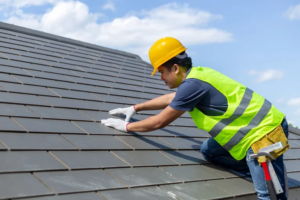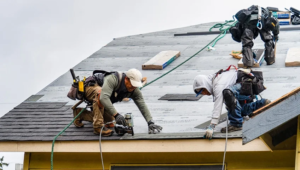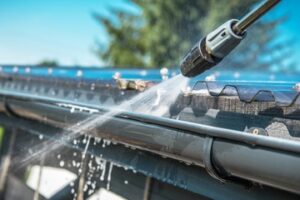A roof is a covering that protects a home or building against rain, snow, sunlight, and temperature extremes. It also helps keep the building structurally sound and comfortable.
The word roof originally had two plural forms: roofs and rooves. It’s not clear why rooves dropped out of use. Contact MT Roofing now!

The ridge is a common structural element of pitched roofs (gable, gambrel, and mansard styles). It runs the entire length of your roof.
Sheet metal
Whether you’re building a new home or remodeling an existing one, metal roofing can add beauty and functionality to any structure. It is highly durable and comes in a wide variety of colors, shapes, sizes, and styles. In addition to its aesthetic appeal, it can also help reduce your energy costs by keeping your property cool in summer and warm in winter.
Sheet metal roofing is incredibly resilient against severe weather and other environmental factors that can affect traditional shingles or other types of roofs. It’s impervious to mold, mildew, moss, and other harmful organisms that can damage the surface of your roof and shorten its lifespan. In addition, it’s naturally resistant to rodents, bugs, and raccoons.
Another benefit of sheet metal roofing is its lightweight nature, which helps reduce the amount of stress it puts on a roof’s support structures. This makes it a great choice for homes in seismic areas. Moreover, it can be easily installed without special tools and equipment. It’s also available in different colors to match the style of your home or business.
Metal panels are made from light-gauge steel or galvalume (a combination of steel, aluminum, and zinc). They’re rolled in a factory using roll forming machines that flatten and shape the sheet into various standing seam profiles. Once the sheet has been formed, it’s sheared to the correct length for use in roofing. These panels can be curved to a radius of up to 20 feet in the factory or on site.
The corrugation process strengthens the metal by forcing a series of alternating grooves and ridges into it. This increases the tensile strength of the steel, which is a critical factor in its durability against all kinds of weather. In addition, the metal is coated with a corrosive protective coating, which further extends its longevity.
The durability of a metal roof makes it an excellent option for warehouses and other industrial buildings. It can be attached directly to the structural framing, which can reduce the cost of construction and installation. In addition, it can withstand high winds and severe weather conditions that are common in these environments.
Plywood
Plywood is a versatile and durable material that can be used to protect your roof. It is available in a variety of thicknesses and finishes, and it can be cut to size on-site by your roofing contractor. There are many different types of plywood, but the two most common for roofing are OSB and CDX. Both have pros and cons, so you should consider the type of roofing you need before choosing a specific product.
The first thing to consider is the climate where you live. While OSB can be used in most climates, it may not perform as well as plywood in humid or wet conditions. It can also swell and take longer to dry than other materials, such as LVL (laminated veneer lumber), making it less suitable for roofing.
Another consideration is the quality of the plywood you choose. While OSB is an inexpensive option, it can be prone to moisture damage and contains formaldehyde, which can be harmful to the environment. Plywood is made with waterproof glues and high-quality wood, making it a safer choice for long-term use. It is also resistant to rot and insect infestation, which are common problems in some regions.
Oriented strand board is created by gluing together small pieces of wood and compressing them tightly, while CDX plywood is made from layers of wood glued to one another. Both have their benefits, but the best choice for your roof will depend on the load-bearing capacity and environmental conditions you are facing.
It is also important to understand how the plywood you are using is produced. While the wood industry has made significant progress in reducing its environmental impact, some issues still remain. For example, old-growth trees are often removed to create plywood, causing deforestation and affecting the biodiversity of the forest. It is therefore essential to choose a plywood product that is sourced from sustainable forestry practices.
When choosing a plywood for your roof, make sure you use exterior-grade sheets. This will help you avoid moisture damage and ensure that your roof is properly supported. It is also a good idea to select a product that has been treated with chemicals to resist rot and insect damage.
Metal roofs
Metal roofs are a great way to protect your home from harsh weather conditions. They can also reduce your energy bills by reflecting sunlight and heat away from the house. They are available in a wide range of colors and styles and can match almost any architectural style. Some homeowners even claim that having a metal roof can lower their insurance rates.
One of the most popular choices for metal roofing is corrugated steel. This type of roof is usually found on commercial or barn structures, but it can be used for residential homes as well. This roof is cost-effective, durable, and provides excellent water resistance. Another option is standing seam metal, which is more expensive but offers a sleeker appearance.
A metal roof can be made from several different materials, including galvanized steel, aluminum, or a combination of these two. The galvanized coating helps to prevent corrosion, and the metal can be coated in various colors. Some manufacturers use a blend of zinc and aluminum to create a non-corrosive product, which is often referred to as “zincalume” or “galvalume.”
Most metal roofs are manufactured in prefabricated panels, which make them easier to install. Some have a concealed fastener system, which makes the panels less susceptible to leaks and other problems. Other systems have exposed fasteners and may require more maintenance.
Choosing a metal roof is a major investment, so it’s important to understand the pros and cons before making a decision. A metal roof will last 2-3 times longer than a traditional asphalt shingle roof, and can save you money in the long run. It’s also a good idea to consult with a local roofing contractor before installing a new roof.
A metal roof will add to the value of your home and can be a beautiful complement to any architectural style. It’s also easy to maintain and will not need replacing as quickly as a traditional shingle roof. Many home insurance companies offer discounts for those who have a metal roof.
A metal roof can be more expensive than a shingle roof, but it’s worth the extra investment. They are durable, water-resistant, and can last for decades. They’re also non-combustible, and can help to protect your home from fires.
Warranties
A warranty is a promise from the manufacturer or roofing contractor that they will take responsibility for certain problems with your roof. These warranties may cover materials or installation, and they usually last for a certain period of time. They can be voided if the roof isn’t properly maintained or installed, so it’s important to read the fine print carefully. Warranties vary in terms of duration, coverage, exclusions, and transferability. They can also be complicated, so it’s best to have a lawyer review them before signing.
A roofing warranty is a great way to protect yourself from manufacturers’ defects and poor workmanship during your roof installation project. However, it’s not necessarily an insurance policy against damages caused by natural disasters such as hail or lightning. In addition, many roofing warranties will not cover repairs to damaged areas if they occur within a certain period of time after the installation.
If you want to purchase a warranty for your roof, make sure that you choose a reputable and knowledgeable contractor who is certified by the roofing product manufacturer to install it. Most shingle manufacturers offer basic warranties that are provided free of charge, but they may also offer enhanced warranties for more coverage. These warranties typically cost more and require that the contractor follows strict installation requirements.
Most manufacturers’ warranties will cover the roofing materials for 20-50 years, but they will not replace your roof if it is damaged by heavy snowfall or hail. Therefore, it is important to find a roofing company that offers a roof workmanship warranty in addition to the manufacturer’s warranty.
Many roofing warranties are void if you use a different contractor to perform maintenance or repair work on your roof. This is because most warranties have language in them that voids the warranty if another company alters the original installation. However, if you are able to find a contractor who will provide ongoing maintenance and repair services, you can avoid this issue and keep your warranty in place.
Having a well-maintained roof can reduce your heating and cooling bills, improve your home’s resale value, and extend the life of your roofing system. In order to maintain a high-quality roof, it is essential to keep detailed records of all work performed on your home. These records can include the contractor’s name, phone number, and address. In addition, they should also list any warranties that have been purchased. Keeping these records will help you to file a claim if the need arises.

